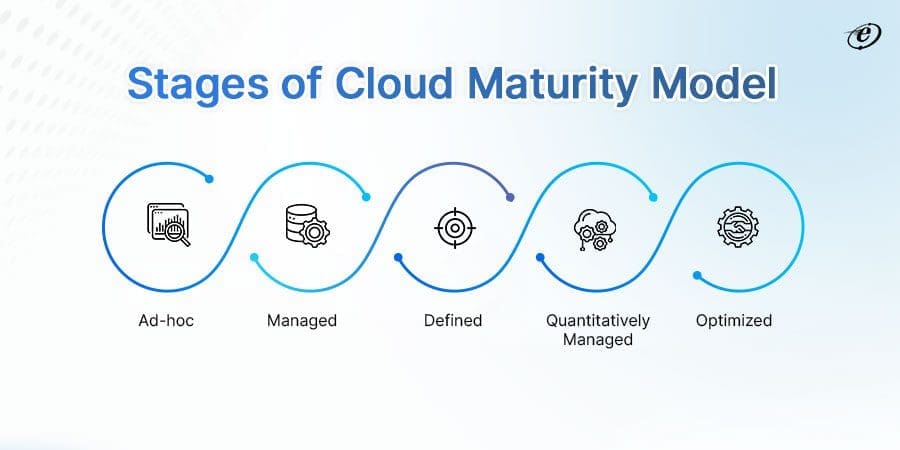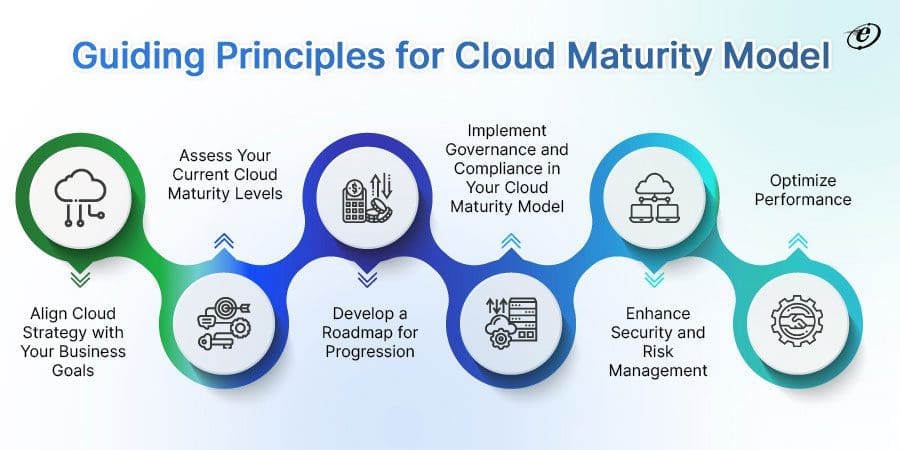
Your Guide to Cloud Maturity Model — Definition, Stages & Guiding Principles
Did you know that by 2025, 85% of enterprises will prioritize cloud-first strategies, but only 20% of their workloads will be cloud-native? This gap underscores the need for a clear framework to guide cloud adoption. But how do you fill this gap? The answer to this is the Cloud Maturity Model (CMM).
Many companies struggle to harness the full potential of cloud computing due to piecemeal and unclear strategies. The Cloud Maturity Model, in that case, acts as your roadmap for assessing your current cloud capabilities, spotting gaps, and advancing systematically.
Therefore, it can be said that the Cloud Maturity Model is more than just a technical word — it can be a game changer for your business innovation and efficiency. However, as a decision-maker, you must go in the right direction to make your business more competitive, secure, and efficient.
This blog explores the A—Z fundamentals to guide you in the right direction. So what are you waiting for? Scroll down to continue learning.
What is a Cloud Maturity Model?
The Cloud Maturity Model, abbreviated as CMM, is a framework that assists your business in assessing its current cloud adoption and readiness. It guides your business through various stages of cloud maturity, ensuring a strategic and effective transition to cloud computing.
Therefore, CMM is essential to identify gaps, plan future growth, and optimize cloud investments for your organization.

Want to protect your organization’s data privacy? Learn the types of cloud security risks and how to tackle it. Find out Cloud Security Risks to know more!
Stages of Cloud Maturity
Now that you know what a Cloud Maturity Model is, it’s time to understand its five stages to gain detailed strategic insight.
Without much ado, let’s get started!

Stage 1: Initial (Ad-hoc)
At the initial stage, cloud adoption is uneven and needs a cohesive strategy and structure. Therefore, you can experiment with cloud services project-by-project without a standardized process or guidelines. You can characterize this stage as a reactive approach to cloud adoption, which is often driven by immediate needs rather than long-term planning.
However, this uneven and unstructured strategy can lead to inconsistent and fragmented cloud deployments as you focus on short-term problems or take advantage of specific cloud capabilities on an as-needed basis. This can result in various teams or departments of your business independently adopting cloud solutions without coordination, which paves the path to inefficiencies and potential security risks. Your primary goal at this stage is to explore and understand the benefits of cloud technology but without the guidance of a comprehensive cloud strategy.
Let’s take a glance at the characteristics and challenges this stage poses.
Characteristics
- The cloud usage is unstructured.
- There’s a limited understanding of cloud benefits and best practices initially.
- There is inconsistency in security and compliance measures.
Challenges
- There’s a lack of visibility and control over cloud resources.
- You can face difficulty in managing costs and ensuring security.
- Lack of coordination and inefficiencies due to duplicate efforts.

Learn what are the best migration tools for your business in 2024 today to stay ahead of the curve. Cloud Migration Tools Guide
to read more!
Stage 2: Managed (Repeatable)
In the managed stage, you need to establish more structured and repeatable processes for cloud adoption. This stage marks your business’s significant shift from the ad-hoc, project-based approach to a more organized and systematic way of utilizing cloud services. The primary focus should be to create consistent and predictable cloud operations.
At this stage, it’s time to start developing standardized procedures and guidelines for deploying and managing cloud resources for your business. These standards help ensure cloud usage is more controlled and aligned with your business goals. It would be best if you also emphasized building the necessary skills and knowledge among your IT staff through training programs and knowledge-sharing sessions.
Let’s glance at the key initiatives and improvements you need to take.
Key Initiatives
- You need to develop standardized procedures for cloud deployment and management.
- Establish a governance framework that will oversee your cloud activities.
- Conduct training and knowledge transfer sessions to improve the skills of your IT staff regarding cloud technologies.
Improvements
- Your cloud usage will become more predictable and controlled.
- You’ll have clear and enhanced visibility and can track your cloud resources.
- This step will mark your initial step toward cost management and security compliance.
Stage 3: Defined
At the third stage of the Cloud Maturity Model, you need to establish comprehensive and documented processes for your cloud adoption and usage. This stage marks a transition to a more mature approach where cloud initiatives are fully integrated into your overall business strategy.
Your organization must consistently follow cloud processes and best practices across all departments. This ensures a uniform and standardized approach. This alignment facilitates better coordination and collaboration, leading to more efficient and effective cloud usage. You must focus intensely on training and development to enhance your employees’ cloud expertise. Also, implement rigorous governance and compliance frameworks to ensure all your cloud activities meet regulatory and organizational standards. This stage emphasizes standardization, documentation, and strategic alignment, resulting in your improved resource management and a solid foundation for your organization’s future cloud advancements.
Let’s take a glance at this stage’s characteristics and the improvements.
Characteristics
- Consistent application of cloud standards and procedures across your organization.
- Better coordination and collaboration across different teams.
- Increased focus on strategic cloud projects.
Improvements
- The comprehensive documentation of cloud processes is established, and best practices are followed.
- The cloud strategy is aligned with your overall business objectives.
- Your employees’ knowledge about cloud expertise deepens due to enhanced training programs and KT sessions.

Master the cloud scalability of your organization today with this comprehensive guide. Cloud Scalability Tips 2025
Stage 4: Quantitatively Managed
At this stage of the Cloud Maturity Model, you must take a data-driven approach to managing and optimizing your cloud environments. This stage is characterized by implementing detailed performance metrics and key performance indicators (KPIs) to monitor and manage your cloud resources effectively. Your decision-making is primarily influenced by data and analytics, enabling you to identify areas for improvement and optimize cloud operations based on measurable outcomes.
It would help if you utilized advanced tools and technologies to monitor your cloud infrastructure continuously. This lets you track real-time performance, cost, and security metrics, providing deep insights into cloud operations. Your emphasis should be on achieving high efficiency and effectiveness by leveraging data to drive decisions. Continuous improvement processes will gradually fall into place to ensure that your cloud strategies evolve in response to changing business needs and technological advancements. By focusing on quantitative management, you can better predict costs, enhance your business’s performance, and ensure strong risk management and compliance.
Let’s take a glance at the advancements and benefits of this stage:
Advancements
- Implementation of detailed performance metrics and KPIs to manage your resources effectively.
- Data-driven decision-making processes.
- Continuous monitoring and optimization of your cloud resources.
Benefits
- Improved efficiency and performance of your cloud operations.
- Enhanced ability to predict and control your costs.
- Better risk management and compliance with regulatory standards.
Stage 5: Optimized
When at the optimized stage of the Cloud Maturity Model, you have reached the pinnacle of cloud maturity. This stage is characterized by the continuous refinement and enhancement of cloud operations based on real-time feedback and performance data. You can leverage advanced automation, orchestration, and innovative technologies to achieve unparalleled efficiency, agility, and resilience in your cloud environments.
Your cloud processes are fully automated and orchestrated, minimizing manual invention and maximizing your business’s operational efficiency. At this stage, your business is highly adaptable and capable of rapidly responding to changing business needs and tech advancements. This level of maturity ensures that your cloud resources are used to their full potential and drive significant value to your business. The optimized stage represents the ultimate goal for any organization looking to capitalize fully on the benefits of cloud computing.
Let’s take a look at the characteristics and benefits this stage offers.
Characteristics
- Advanced automation and orchestration of cloud processes take place.
- Continuous improvements and innovations happen in your cloud services.
- Proactive identification and mitigation of risks.
Benefits
- Maximized efficiency and performance of your cloud operations.
- Rapid adaptation to your changing business needs and tech advancements.
- Sustained competitive advantage through innovative use of cloud technologies.

Want to manage the cloud security posture of your organization but don’t know how to do it? Cloud Security Posture Guide to learn all about it!
Benefits of the Cloud Maturity Model
Adopting the Cloud Maturity Model (CMM) is a strategic transformation that enhances your business efficiency, scalability, and resilience. As you progress through different stages of cloud maturity, you unlock numerous benefits that improve your operational agility and competitive advantage. Here’s how:
1. Optimized Cost Management
One of the biggest advantages of cloud maturity is the ability it provides you to maximize cost efficiency. In the early stages, you can often struggle with unpredictable cloud expenses due to ad-hoc implementations. However, as they mature, they develop a structured approach to resource allocation, leveraging auto-scaling, cost monitoring, and optimized workloads. This reduces your wasteful spending and ensures a better return on investment.
2. Enhanced Security and Compliance
With cloud adoption comes the responsibility of securing sensitive data and ensuring compliance with industry regulations. A well-defined cloud maturity strategy incorporates advanced security protocols, automated threat detection, and compliance frameworks, minimizing the risks associated with data breaches and cyber threats.
3. Increased Operational Efficiency
A mature cloud environment streamlines your business operations by automating routine tasks, improving system reliability, and reducing downtime. With cloud-native tools, DevOps practices, and AI-driven analytics, you can accelerate deployments, enhance collaboration, and optimize your workflows for maximum efficiency.
4. Greater Scalability and Flexibility
When you reach higher levels of cloud maturity, you can scale your resources dynamically based on business demands. Whether handling increased traffic during peak seasons or supporting global expansion, a well-structured cloud environment ensures seamless scalability without compromising performance.
5. Data-Driven Decision-Making
A mature cloud strategy integrates analytics and AI-driven insights, allowing you to make informed decisions based on real-time data. From customer behavior analysis to predictive maintenance, leveraging cloud intelligence enhances your strategic planning and operational outcomes.
6. Business Continuity and Disaster Recovery
Cloud maturity enables you to implement robust disaster recovery (DR) and backup solutions, ensuring your data integrity and minimizing downtime. Automated failover mechanisms, geo-redundancy, and real-time backups allow your business to recover quickly from unexpected disruptions.
7. Competitive Advantage and Innovation
A fully optimized cloud environment fosters innovation by providing the agility you need to experiment with new technologies like AI, IoT, and edge computing. Cloud-mature businesses can rapidly develop and deploy new solutions, keeping them ahead of competitors and driving long-term growth.
Cloud Maturity Model Best Practices
Now that you’re familiar with the Cloud Maturity Model and its five stages, which you need to go through to excel your business in cloud computing, let’s understand what considerations you need to keep in mind while navigating these stages.
Below is a detailed description of the considerations. Let’s dig in!

#1 Align Cloud Strategy with Your Business Goals
Aligning your cloud strategy with your overall business goals ensures your cloud initiatives support and drive your business success. You must start by setting clear, measurable, and practical objectives that align with your business priorities.
Your cloud strategy should be designed to achieve your goals, whether you aim to reduce costs, improve scalability, enhance security, or drive innovation. Review and adjust your cloud strategy regularly to align with evolving business needs and market conditions.
#2 Assess Your Current Cloud Maturity Levels
Understanding your current cloud maturity level is the first step toward advancement. Conduct a thorough assessment using established frameworks and tools to evaluate your existing cloud capabilities.
Identify strengths and weaknesses in your current setup, focusing on areas like process standardization, governance, security, and performance. This assessment will provide a clear picture of where you stand and what needs to be addressed to move to the next maturity stage.
#3 Develop a Roadmap for Progression
Once you understand your current maturity level, develop a strategic roadmap to guide your progression through the cloud maturity stages. This roadmap should outline specific initiatives, timelines, and resource allocations needed to achieve your goals.
Prioritize actions that will have the most significant impact on your business objectives. You can include milestones and checkpoints to monitor your progress and make adjustments as needed.
#4 Implement Governance and Compliance in Your Cloud Maturity Model
Effective governance and compliance are critical as you advance through the stages of the Cloud Maturity Model. Establish robust governance frameworks to ensure all your cloud activities align with the policies and regulatory requirements.
This governance framework includes defining roles and responsibilities, monitoring and reporting mechanisms, and conducting regular audits. A strong governance structure helps control cloud resources, ensures data security, and mitigates risks.
#5 Enhance Security and Risk Management
As you progress through the stages, continuously improve your security and risk management strategies. Implement advanced cloud security maturity models such as encryption, multi-factor authentication, and intrusion detection systems.
You need to conduct risk assessments regularly to identify potential threats and vulnerabilities. Develop and test incident response plans to ensure your organization can handle security breaches effectively. A robust cloud security maturity model will protect your cloud environment and build stakeholder trust.
#6 Optimize Performance
To achieve optimal cloud performance, always leverage advanced analytics and automation tools, atleast at the later stages. These tools can help you monitor and manage cloud resources efficiently, ensuring high availability and performance.
You can also implement automated scaling, load balancing, and performance tuning, which can significantly enhance the efficiency of your cloud operations. Review your performance metrics and make data-driven decisions to optimize your cloud infrastructure continuously.
How Does the Cloud Maturity Model (CMM) Help You?
Now that you know the basics of the cloud maturity model and the guiding principles you should consider, you must be thinking about how it will help your business. Well, your thought is natural. Before you implement any strategy in your business, you must know how it will help your business.
So, let’s take a look at how the cloud maturity model assists your business:
- CMM helps you evaluate your existing cloud usage and capabilities and identify strengths and areas for improvement, which is essential to scaling your business.
- It provides a step-by-step roadmap outlining what needs to be done at each stage of cloud maturity to optimize your cloud investments.
- The cloud maturity model ensures that cloud strategies align with your business objectives, helping you prioritize your investments that deliver the most value.
- It identifies inefficiencies and suggests optimizations that help you manage costs effectively and maximize your cloud ROI.
- It also assists you in identifying potential risks and ensuring compliance with regulatory requirements as you progress through your cloud journey.
Wrapping Up!
Before we end, let’s have a quick recap to memorize the discussions we had in this blog:
- The Cloud Maturity Model provides a structured framework for assessing and improving your cloud adoption and cloud computing maturity model.
- From Ad-hoc to Optimized, each stage represents a significant leap in cloud capability and strategic alignment.
- Align cloud strategy with your business goals to leverage the full potential of cloud computing services.
Last but not least, reaching the highest level of cloud maturity is not just an endpoint but an ongoing journey of continuous improvement and innovation. By understanding and strategically navigating the Cloud Maturity Model, you can fully harness the power of cloud computing, driving efficiency, security, and business growth.
If you’re looking to leverage the full potential of your cloud computing initiatives but don’t know how, don’t worry. Our in-house experts have got your back! All you need to do is schedule an appointment, and we’ll get it sorted for you.
Frequently Asked Questions
1. Why is advancing through the Cloud Maturity Model important?
Advancing through the Cloud Maturity Model is crucial because it helps organizations fully leverage the benefits of cloud computing. By progressing through the stages, you can achieve better efficiency, enhanced security, cost savings, and greater alignment with business goals, ultimately driving business growth and innovation.
2. How can my organization assess its current cloud maturity level?
To assess your current cloud maturity level, start by conducting a thorough evaluation of your cloud usage, processes, and governance. You can use established frameworks and tools to identify strengths and weaknesses, and understand where you stand in the maturity model. This assessment will help you pinpoint areas for improvement and create a targeted plan for progression.
3. What are the key considerations for advancing through the cloud maturity stages?
Key considerations include aligning your cloud strategy with business goals, regularly assessing your maturity level, developing a strategic roadmap for progression, implementing robust governance and compliance frameworks, enhancing security measures, and continuously optimizing performance. These steps ensure you a smooth and effective journey through the cloud maturity model stages.
4. What is a cloud maturity assessment?
A cloud maturity assessment evaluates your current cloud capabilities and readiness. This assessment provides you insights into strengths, gaps, and areas for improvement. It guides your business on the next steps to maximize cloud benefits and align them with your strategic goals.
5. What is the Cloud adoption maturity model?
The Cloud Adoption Maturity Model is a framework that outlines the stages of cloud adoption, guiding your business from initial cloud use to advanced, optimized cloud environments. It provides you a roadmap for evolving cloud strategies, optimizing resources, enhancing scalability, and achieving better alignment with your business objectives.
6. What is the maturity model in cloud security planning?
The maturity model in cloud security planning helps you assess your cloud security levels and improve practices to ensure data protection, compliance, and risk management. By using this model, you can evaluate your current security posture, identify vulnerabilities, and implement more robust security practices needed for your business.
7. Which frontend framework is better: Svelte or Vue or React?
Each framework has its strengths. React is popular and widely used with a strong community, Vue is beginner-friendly with a balance of simplicity and flexibility, and Svelte offers a highly optimized, modern approach with minimal overhead. The best choice depends on your project needs, team familiarity, and performance requirements.
8. When to Choose Svelte?
You should choose Svelte when you need fast, highly performant apps with minimal code. It’s great for small to medium projects, where bundle size and speed are crucial, and when you want a modern, simplified development experience.
9. When to Choose Vue?
You should choose Vue when you need a flexible and easy-to-learn framework that scales well for both small and large projects. It’s ideal if you want a gentle learning curve, a strong ecosystem, and straightforward integration with your existing projects.





